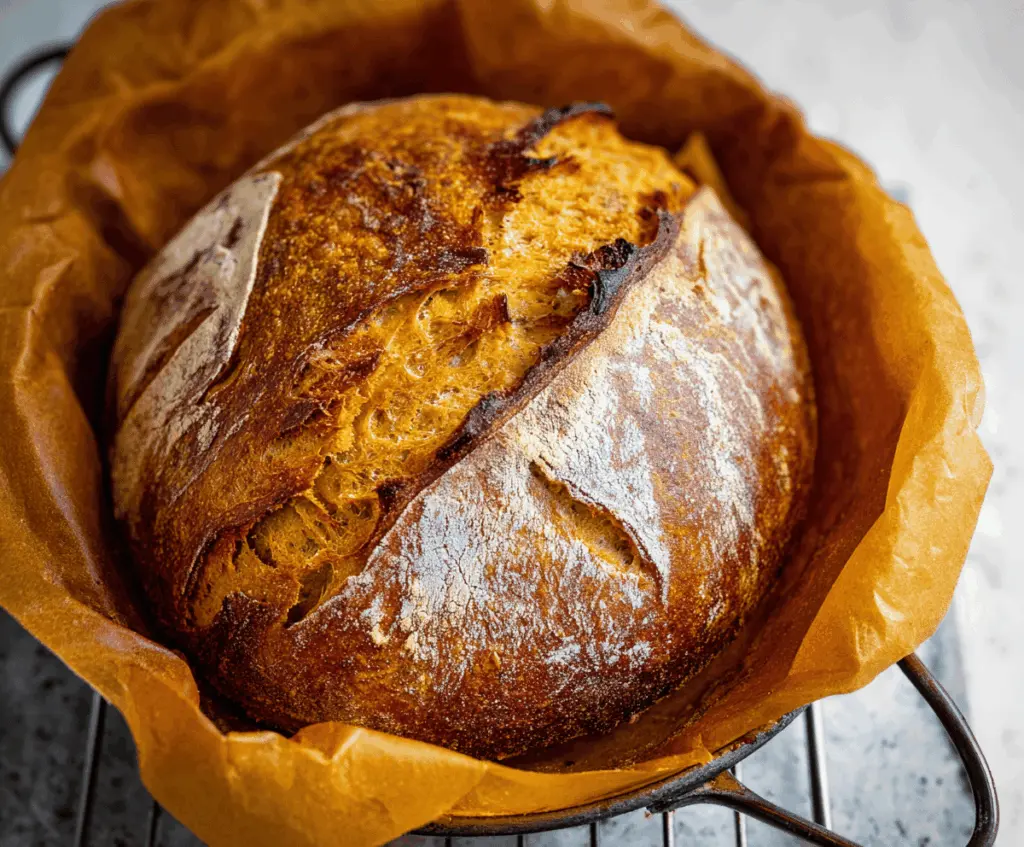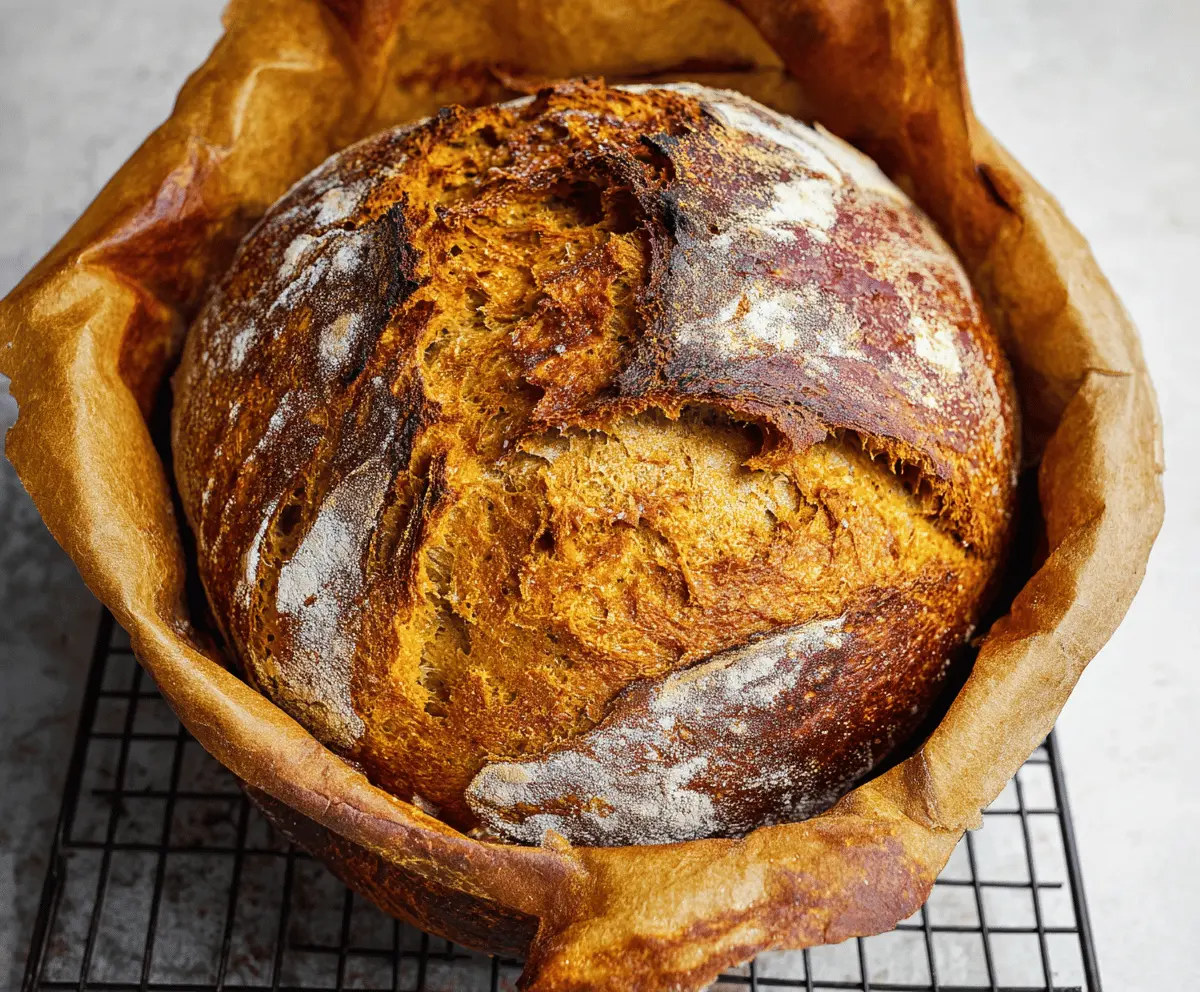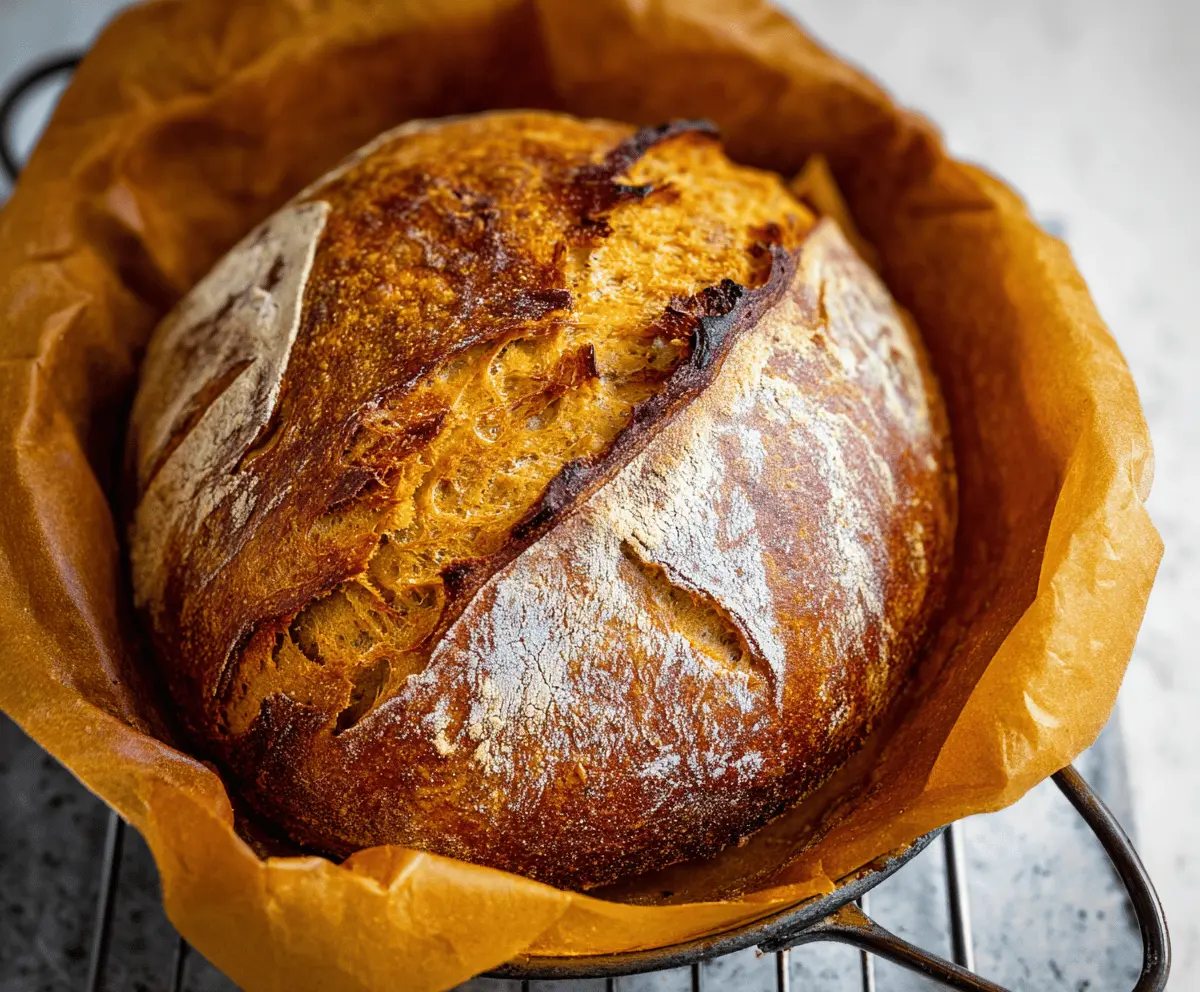
Pumpkin Sourdough Bread
Pumpkin Sourdough Bread is a cozy, flavorful loaf packed with the warmth of pumpkin and the tangy goodness of sourdough. The bread is soft on the inside with a lovely…
Tip: save now, cook later.Pumpkin Sourdough Bread is a cozy, flavorful loaf packed with the warmth of pumpkin and the tangy goodness of sourdough. The bread is soft on the inside with a lovely crust outside, and the subtle sweetness from the pumpkin makes it extra special. It’s the perfect way to add a little fall magic to your breakfast or snack time.
I love making this bread when the weather starts to cool down—it fills the kitchen with that amazing pumpkin scent that instantly feels like a hug. The sourdough starter gives the bread its signature tang, which balances out the pumpkin’s gentle sweetness perfectly. Plus, baking this bread feels like a fun little project that always ends with a delicious reward.
My favorite way to enjoy pumpkin sourdough is simply toasted with a bit of butter or cream cheese. It’s also great for making hearty sandwiches or just eating on its own with a cup of tea. This bread brings a cozy, homemade touch to any meal, and I always find myself making an extra loaf to share with friends or family.

Key Ingredients & Substitutions
Sourdough starter: This is the heart of your bread’s flavor and rise. Use an active, bubbly starter at 100% hydration for best results. If you don’t have sourdough, you could try using commercial yeast, but the flavor will be different.
Pumpkin puree: Adds moisture, natural sweetness, and a soft texture. Canned pumpkin works well, but homemade pumpkin puree is great if you have it. Sweet potato puree is a good alternate if you want a similar flavor.
Bread flour: Gives the gluten structure your bread needs for a good rise. All-purpose flour can work but expect a softer loaf. For a whole grain option, substitute part of the bread flour with whole wheat flour, but reduce liquid slightly.
Spices: Cinnamon and nutmeg add warm flavor that complements pumpkin. These are optional, so adjust to your taste or leave out if you prefer plain bread.
Sweetener: A bit of sugar or honey can help balance the tanginess of the sourdough and enhance the pumpkin flavor. You can skip this if you want a less sweet bread.
How Do You Get a Great Rise and Crust on Pumpkin Sourdough Bread?
Pumpkin adds moisture, which can make the dough softer and harder to handle. Here’s how to manage that:
- Use stretch-and-folds: This gentle folding strengthens gluten without heavy kneading. Do it every 30 minutes during bulk fermentation to build structure.
- Don’t add too much liquid: Measure water carefully since pumpkin puree adds moisture too. Adjust slightly if dough feels too sticky.
- Preheat your Dutch oven: Baking covered traps steam, which gives you a nice crust and good oven spring. Preheat the pot for at least 30 minutes to ensure the bread bursts and cracks beautifully.
- Score the top: A sharp knife or blade lets steam escape and guides the bread to expand properly. It also gives a nice rustic look.
- Cool before slicing: Letting the bread cool fully helps the crumb set and prevents a gummy texture inside.
Equipment You’ll Need
- Large mixing bowl – perfect for mixing and letting your dough rest comfortably.
- Bench scraper – helps you handle sticky dough and shape the loaf easily.
- Dutch oven or heavy oven-safe pot with lid – traps steam for a crispy crust and even baking.
- Proofing basket or bowl with a floured kitchen towel – supports the dough’s shape during the final rise.
- Sharp knife or bread lame – essential for scoring the dough so it can expand beautifully as it bakes.
- Kitchen scale – ensures accurate measuring of ingredients for consistent results.
Flavor Variations & Add-Ins
- Add toasted pumpkin seeds on top before baking for extra crunch and nutty flavor.
- Mix in a handful of raisins or dried cranberries for a touch of natural sweetness that pairs well with spices.
- Stir in warm spices like cloves or ginger if you want more autumn warmth in every bite.
- Fold in some chopped walnuts or pecans to add texture and a toasty note.
How to Make Pumpkin Sourdough Bread?
Ingredients You’ll Need:
- 1 cup (240g) active sourdough starter (100% hydration)
- 1 cup (240g) pumpkin puree (canned or homemade)
- 1 ½ cups (360ml) lukewarm water
- 4 cups (480g) bread flour
- 1 ½ tsp salt
- 1 tsp ground cinnamon (optional)
- ½ tsp ground nutmeg (optional)
- 1 tbsp sugar or honey (optional, for slight sweetness)
- Cornmeal or flour for dusting
How Much Time Will You Need?
This recipe takes about 4 to 6 hours of active and resting time combined, plus extra time if you choose to proof the dough overnight in the fridge for deeper flavor. Most of this time is for fermenting and proofing, so hands-on work is minimal.
Step-by-Step Instructions:
1. Prepare the Dough:
Make sure your sourdough starter is active and bubbly by feeding it a few hours before starting. In a large mixing bowl, mix the starter, pumpkin puree, and lukewarm water until smooth. Add bread flour, salt, and spices if using. Stir to create a rough, shaggy dough.
2. Autolyse and Develop Gluten:
Cover the bowl with a damp towel or plastic wrap and let the dough rest for 30 to 45 minutes. After the rest, perform a series of stretch-and-folds in the bowl every 30 minutes for 2 to 3 hours. This technique helps develop the dough’s structure gently without kneading.
3. Shape and Proof:
Once the dough has risen and shows bubbles (about 3-4 hours total fermentation), turn it out onto a floured surface and shape it into a round loaf (boule). Place the shaped dough seam-side up in a heavily floured proofing basket or a bowl lined with a floured towel. Let it proof for 2 to 4 hours at room temperature until puffed, or place it in the fridge overnight for a slower, more flavorful proof.
4. Bake the Bread:
Heat your oven to 450°F (230°C) with a Dutch oven or heavy oven-safe pot inside for at least 30 minutes. When ready, turn the dough out onto parchment paper, score the top with a sharp knife, and carefully place it into the hot Dutch oven. Cover with the lid and bake for 20 minutes. Remove the lid and bake another 20 to 25 minutes until the crust turns a deep golden brown and crackly.
5. Cool and Serve:
Remove the bread from the oven and cool it completely on a wire rack. This cooling step is important to let the crumb set nicely. Once cool, slice and enjoy with butter, cream cheese, or your favorite spread!
Can I Use Frozen Pumpkin Puree?
Yes! Just make sure to thaw it completely and drain any excess liquid before adding it to the dough to keep the texture balanced.
What If I Don’t Have a Dutch Oven?
You can bake the bread on a preheated baking stone or heavy baking sheet. To create steam for a crusty exterior, place a pan of hot water on the oven floor during the first 15 minutes of baking.
How Should I Store Leftover Pumpkin Sourdough Bread?
Store it in a paper bag or wrapped loosely in a kitchen towel at room temperature to keep the crust crisp. It’s best eaten within 2-3 days. For longer storage, slice and freeze the bread.
Can I Add Nuts or Seeds to This Bread?
Absolutely! Fold in a handful of toasted walnuts, pecans, or pumpkin seeds during the shaping stage for extra texture and flavor.

Pumpkin Sourdough Bread
Naturally leavened sourdough loaf enriched with pumpkin purée for color and softness. Bake same day or proof overnight for deeper flavor.
Ingredients You’ll need
- 1 cup (240 g) active sourdough starter
- 1 cup (240 g) pumpkin purée
- 1½ cups (360 ml) lukewarm water
- 4 cups (480 g) bread flour
- 1½ tsp salt
- 1 tsp ground cinnamon (optional)
- ½ tsp ground nutmeg (optional)
- 1 tbsp sugar or honey (optional)
- Cornmeal or flour for dusting
Instructions Step-by-step
- Whisk starter, pumpkin purée, and lukewarm water until smooth. Add flour, salt, and optional spices or sweetener. Mix to a shaggy dough.
- Rest 30–45 minutes (autolyse). Perform 3–4 sets of stretch-and-folds every 30 minutes for 2–3 hours.
- When dough is puffy with small bubbles (about 3–4 hours bulk), shape into a tight round (boule).
- Place seam-side up in a floured banneton or towel-lined bowl. Proof 2–4 hours at room temperature, or refrigerate overnight.
- Preheat oven to 450°F (230°C) with a Dutch oven inside for 30 minutes. Invert dough onto parchment, score, and load into the hot pot. Bake covered 20 minutes, then uncovered 20–25 minutes until deep golden.
- Cool completely on a rack for at least 1 hour before slicing.
Notes: For stronger tang and easier scoring, cold-proof 8–12 hours. If dough feels tight, add 1–2 tbsp water; if sticky, dust lightly during shaping.
Nutrition (per slice) & Tips
- Add-ins: pepitas, raisins, or chocolate chips (fold in after bulk).
- Spices: swap cinnamon/nutmeg for pumpkin pie spice.
- No Dutch oven: bake on a stone with a tray of boiling water for the first 15 minutes.
